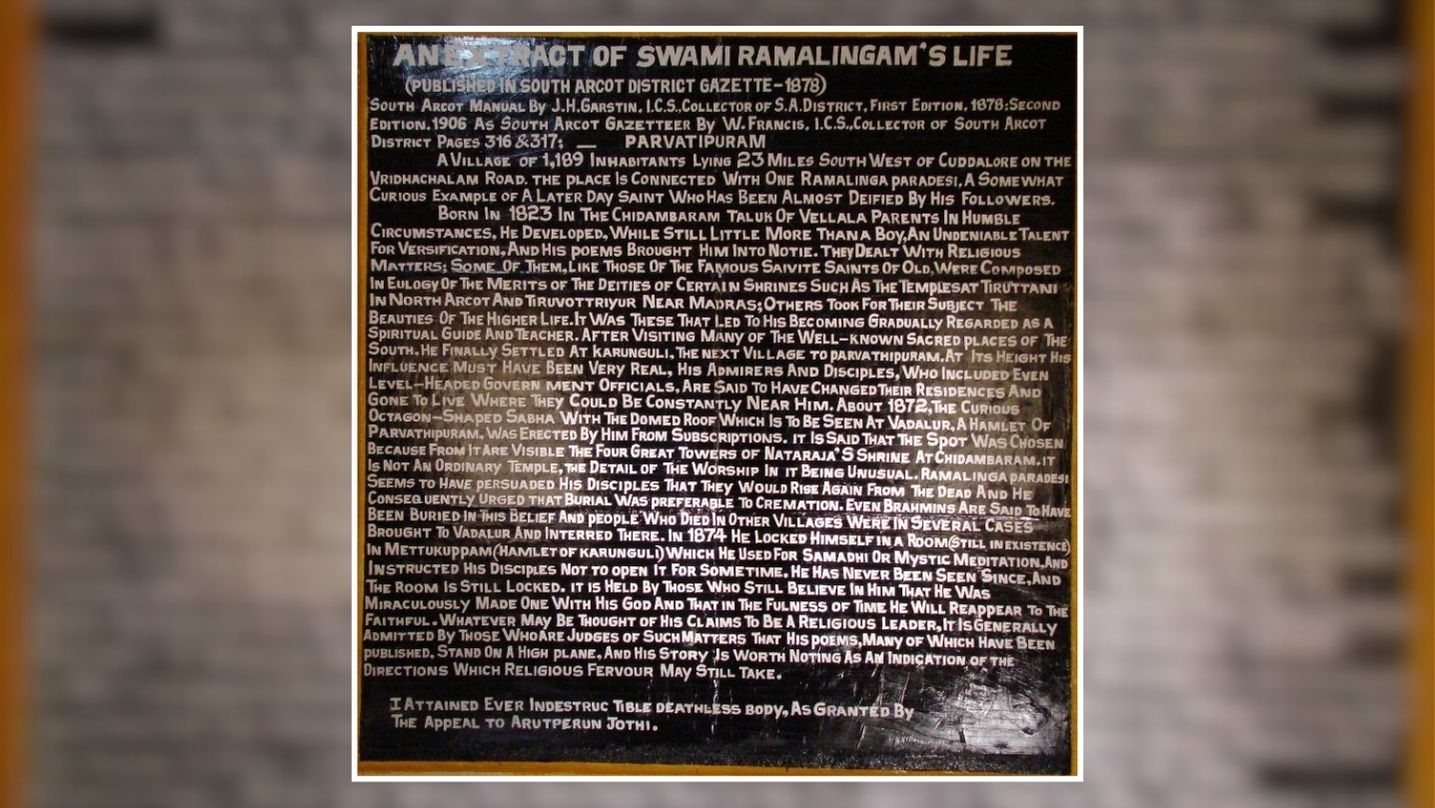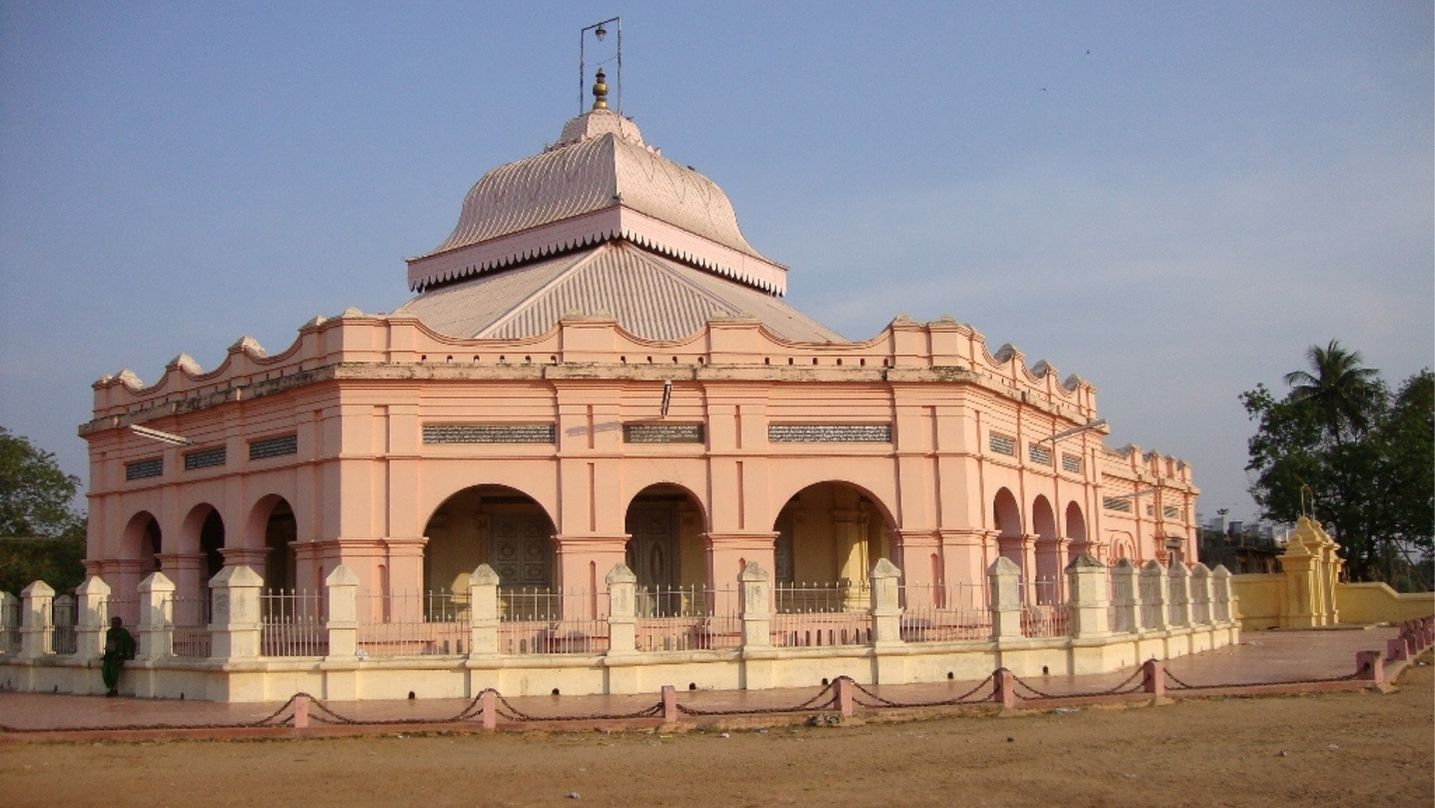
Many Saints and Sages have been born in Southern India. Their mission was to uplift humanity by leading them towards experiencing the divine. They spread their teachings through many literary works in regional languages and by establishing organisations that serve the society. Though many centuries have passed, their teachings remain intact and contemporary, attracting followers in large numbers. One such spiritual guru belonging to Tamil Nadu is Saint Ramalinga Swamigal.
Sri Ramalinga Swamigal is popularly called Saint Vallalar by his devotees and followers. He is not only a saint but also an excellent Tamil poet belonging to the 19th Century. Saint Vallalar was born Ramalingam on 5th October 1823. He was the youngest child born to Ramaiah Pillai and Chinnamaiar in a small village called Marudur near Chidambaram.
Early years
When Ramalinga Swamigal was just five months old, his parents took him to the Thillai Natarajar temple in Chidambaram. When the priest performed the Aarthi to the Lord, the infant had his first deep spiritual experience. He had tears of ecstasy pouring down from his eyes while he smiled at the Lord.
Ramalinga Swamigal had an elder brother. He was married to Pappathi Amma. They lived in Chennai. In 1824, Ramalinga Swamigal's father passed away. Ramalinga Swamigal and his mother had no choice. They moved in with his elder brother, Sabhapathi.
Sabhapahti deemed it fit to educate his younger brother, Ramalingam. But, to his dismay, he found his younger brother was least interested in education. He discovered Ramalinga Swamigal skipping his lessons. They had to locate him in temples nearby. Ramalinga Swamigal regularly visited the Kandhaswamy temple.
One day, Sabhapathi lost his temper and ordered his wife not to feed Ramalinga Swamigal as he skipped his lessons continuously. But, the kind-hearted Pappathi amma fed Ramalinga Swamigal. She also pleaded with him to learn. Finally, Ramalinga Swamigal agreed and asked for a room, a mirror and a lamp to study. These were granted to him. Instead of studying, he lit the lamp in front of the mirror and facing the mirror, he went into deep meditation. He was an ardent devotee of Lord Shiva and Lord Muruga. He soon saw the divine vision of Lord Muruga.
Sabhapathi was a learned man. He used to give spiritual discourses - religious stories from our sacred texts. Due to unforeseeable circumstances, Sabhapathi could not deliver his discourse one day. Ramalinga Swamigal replaced him as a substitute and delivered the Upanyasam. Ramalinga Swamigal narrated the Periyapuranam written by the Tamil scholar Sekkhizhar. The Periyapuram is a sacred text followed by the Shaivaites. It describes the various happenings of the 63 Nayanmars. The way Ramalinga Swamigal uttered the verses and the uninterrupted flow of the words mesmerised the audience. They felt his discourse was better than that of his brother.
Saint Vallalar was an exemplary poet. His book, Thiruarutpa ( Holy book of the divine grace), is the most well-read by the devotees. Many artists still sing his divine compositions in music concerts. He always advocated justice and love for all living beings and has authored a book on the way of life called the Jeeva Karunya Olukkam. His book, Manu Muraikanda Vaasagam is also famous. It describes King Manu Needhi Cholan.
He was compelled to marry his niece when he was young. However, on the night of his wedding, he was discovered reading the Thiruvasagam. Finally, Ramalinga Swamigal renounced the world and dedicated his life to the cause of humanity.
Miracles of Vallalar
Ramalinga Swamigal / Saint Vallalar met Venkata Reddiar, who invited him to stay with him in Karunguzhi. He accepted the offer and moved from Chennai. It was during this time that he started composing divine songs. Initially, his songs were on different deities. As days passed, the songs became more pronounced on the supreme and divine light - Jyothi.
One night, while he was composing, the lights in the lamps slowly began fading away. Oil in the lamps was over. Saint Vallalar could not find oil at home. He poured water into the lamps. To the amazement of everyone, the lamps burnt the whole night. He could finish his divine compositions.
Saint Vallalar always insisted that his devotees meditate on the omnipresent, formless and religionless Jyothi (light). He gave us the Maha Mantra: Arutperunjothi arutperunjothi thaniperum karunai arutperunjothi
meaning: Supreme light that is graceful, supreme compassion that is graceful light.
He was against preserving his image in the form of paintings or photographs. He discouraged his devotees from worshipping his image or statue. Once, a staunch devotee hired a photographer to click pictures of the Saint. The photographer clicked many photos of the Saint. Finally, when he processed the negative, they were amazed to find the Saint's picture missing from it. All they could see in the photograph was the robe he wore. Ramalinga Swamigal always insisted the divine was formless. He said that it is human nature to attach oneself to a tangible form and, in the process, fail to meditate upon the Divine.
Many devotees have also observed that while Swamigal /St. Vallalar walked under the sun, his body never cast a shadow.

One day, unexpectedly, many guests arrived at the Dharma Salai. Dharma Salai is the place established by the saint to offer free food to anyone hungry. The inmate devotees were worried that food was insufficient to feed the guests. They approached the saint. Ramalinga Swamigal cooly replied that he would serve food to the guests that day and started serving food. Soon, the guests were well-fed, but the inmates were shocked to find leftover food in the kitchen.
Ramalinga Swamigal was well-versed in the process of alchemy. He turned copper and iron into gold by plainly touching or holding the metal in his palms. These incidents are recorded in his life history. Swamigal came in contact with many people pursuing alchemy. He demonstrated the process of changing the metals but finally insisted that the people turn their bodies into Gold - A deathless body instead of wasting time transforming merely a metal into gold.
Swamigal used to give lectures at Vadalur. People from near and far would travel to listen to him speak. Swamigal was against castes. People from all castes would attend his speeches. One day, a devotee approached Swamigal and confessed that he owned a meat shop. It was the only business he knew. Swamigal gave the devotee money and asked him to place it in a box. Every day, there was enough money for the devotee when he opened the box. Soon, the devotee closed the meat shop and turned into a vegetarian. The saint advocated Jeeva Karunyam - reverence and compassion for all forms of life.

During his final days, Saint Vallalar lived in the village called Mettukuppam. One Thai Poosam day of 1874 ( 30th January), Saint Vallalar entered a room and locked himself. He asked his devotees not to disturb him. The room remained bolted for several months. One day, the room was forced open by the Government officials. To everyone’s amazement, the room was empty. The saint had left no body. He had merged himself with the supreme divine ( leaving no body behind). This incident has been recorded by the British in the Gazette.
Establishments
Ramalinga Swamigal was highly compassionate. He would feel sad even if he saw a plant dying. He advocated for people to be vegetarians. He always insisted that people should never go hungry. Hence, he started the Sathya Dharma Salai in Vadalur in 1867. Here, hot vegetarian food is still being served for free. The Saint lit the fire for the first time while establishing this place, and the fire is still burning after all these years. Even at night, a person is allotted the duty to see that the fire is not extinguished.

Ramalinga Swamigal established the Sathya Gnana Sabhai at Vadalur in 1872. The building is designed in a hexagonal shape. From the top, it looks like a lotus. This is a place where people gather to meditate and soak in the positive vibrations. There are no idols of any Gods and Goddesses kept in this place. Instead, a burning lamp is kept surrounded by seven veils/curtains. People from all religions and castes can visit this place and pray in the Shabha. However, people who consume meat are not allowed inside. There are no special poojas conducted here, no achagars present nor prasadams given.

Recently, the 200th birth anniversary of Saint Ramalinga Swamigal / Vallalar was observed in October 2023 at Vadalur. The Honourable Prime Minister of India, Shri. Narendra Modi addressed and recalled the teachings of the great Saint. He also acknowledged the organisations that strive to uphold the teachings of the saint. He recalled the compassionate spirit of the Saint and quoted Vallar’s verse on feeding the hungry.
 Vaishnavi Gurusankar is a passionate educator, a wife and a mother. She has over a decade of experience as an educator and has been closely working with teachers and children of all ages. She is also an active parenting blogger and founder of Magical Unicorn, an exclusive parenting blog founded on Indian ethos, values and stories at its core. She has also authored the book "Bharatyam : Science behind Hindu Practices & Way of Life"
Vaishnavi Gurusankar is a passionate educator, a wife and a mother. She has over a decade of experience as an educator and has been closely working with teachers and children of all ages. She is also an active parenting blogger and founder of Magical Unicorn, an exclusive parenting blog founded on Indian ethos, values and stories at its core. She has also authored the book "Bharatyam : Science behind Hindu Practices & Way of Life"
NEXT ARTICLE

At the southernmost tip of this mesmerising ensemble lies the majestic Great Nicobar Island, boasting an impressive landmass of about 910 square kilom...

Bharath has always been a land traversed by spiritual masters/ Guru since time immemorial. These spiritual masters have always upheld the core princip...

South India contains its fair share of unique pilgrimage centres. These divine places of worship have a prominent Sthala Purana, devoted followers, di...